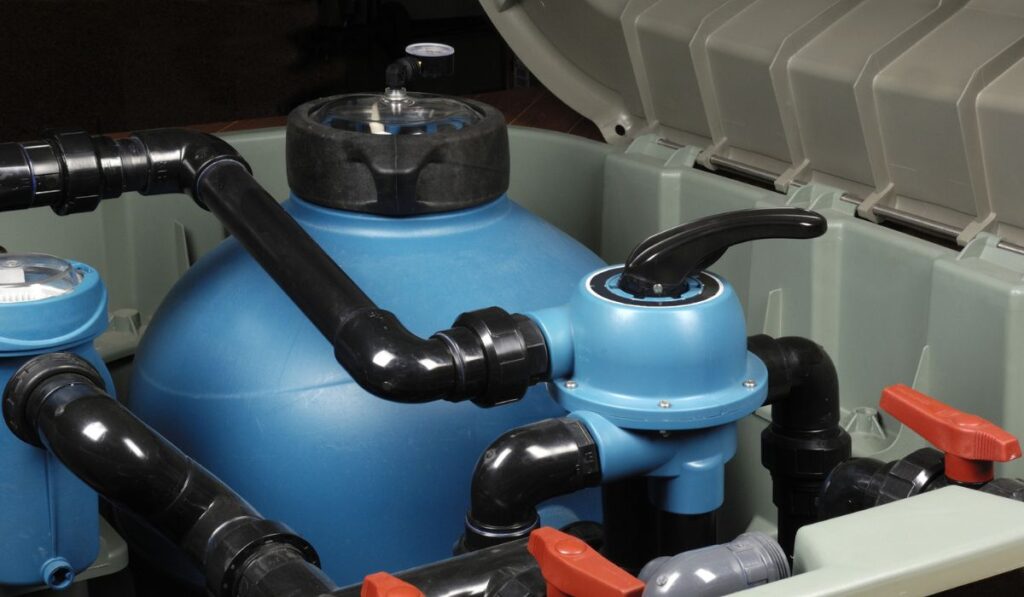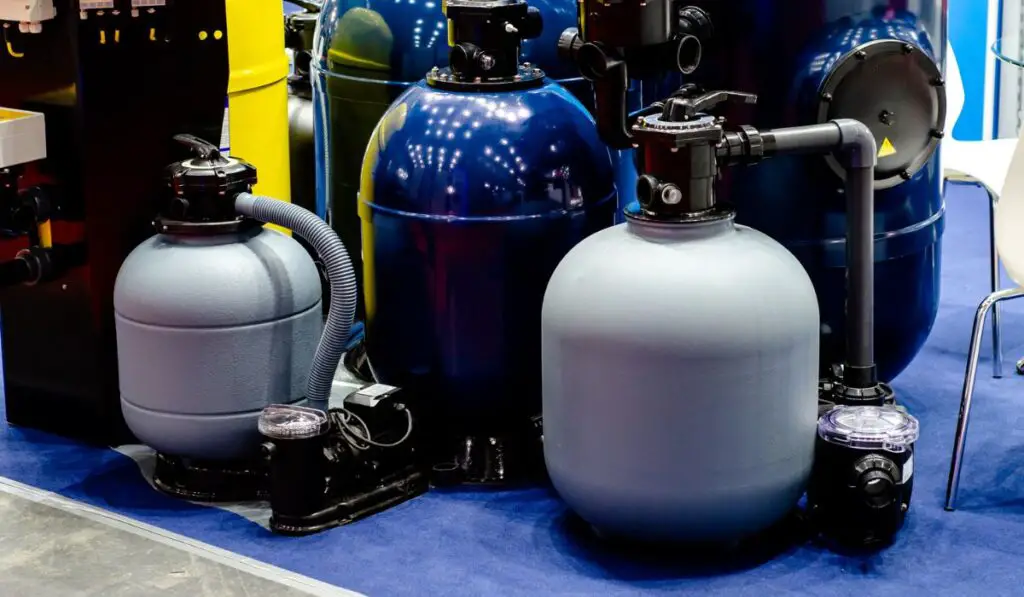Proper maintenance of your filter is an essential part of caring for your pool since it ensures your water stays cleaner for longer. Consequently, you’re going to have to replace the sand in the filter from time to time. So, how often should you change the sand in your pool filter?
You need to replace the sand in your pool filter every 3-5 years, on average. If your pool stays in relatively good condition or is only open occasionally, you can probably wait longer. However, if your pool is open year round, you may need to replace the sand after just 2-3 years.
Let’s dive right into the exciting bits and find out why you need to change the sand and how exactly you’ll go about it. We’ll then cap things off by checking out the various types of sand suitable for the pool filter.
What Is a Sand Filter?

A sand filter like this one (example on Amazon) is an egg-shaped tank attached to your pool’s filtration network, which is used to clean the water. It works just like the filtration system in a fish tank, but rather than using a mechanical filter that runs all day long, it uses sand. Yes, you read it right, sand!
As the water passes through the sand (filter media) in the filter, it grabs and traps gross things inside your pool like algae, bacteria, dirt, and the dead bugs that always float around.
Using a multiport valve, the sand filter directs the water through the filter or out the backwash. The valves are either top or side mount but basically work the same way.
In filter position, the filthy water from your pool is directed over the top of the sand bed, where it flows down through the sand, and the pointy surfaces of the sand catch the impurities.
The clean water is then pushed out of the filter through the lateral assembly with wagon wheel-shaped laterals that have holes along the top edge. These holes release the clean water back to the pool while the sand and dirt remain in the filter.
Why Do You Need to Change the Sand?
As we’ve established, the sand filter heavily relies on sand and its coarseness to work. Unfortunately, as time goes by, the sand ages — its jagged edges gradually wear down, and it becomes smooth. When this happens, the sand loses its efficiency and ability to trap the contaminants, so they pass through it and go back into the pool.
How Often Do You Need to Change the Sand?
As a rule of thumb, replace the sand every 3-5 years. This time frame is applicable if you keep your pool open, but it remains in a relatively good condition, or if it’s only open from late Spring to early Fall and the rest of the year it’s closed (and the filter is off).
However, if you live in a hot climate where you have to keep the pool open all year long, the filter runs frequently with little breaks, meaning the sand breaks down faster. Therefore, in your case, you’ll have to change the sand every 2-3 years or sooner.
How Do You Change the Sand in Your Filter?
Changing the sand in your filter is a fairly complex activity, but with the right tools, you can get it done in no time. You’ll need the following to make the process as painless as possible:
- Screwdriver
- Mask
- Portable vacuum or tiny can
- Garden hose
- Duct tape
- Utility knife
- Pool filter sand
- Backwash hose
Here’s a comprehensive guide on how to do it:
Step 1: Turn off the Pump and Drain the Filter
Turn off the pump and ensure the timer isn’t set to turn on soon. Disconnect the drain plug from the bottom of the filter tank and let all the water drain out.
Step 2: Remove the Multiport Valve
Remove the pipes connected to the multiport valve. If your valve is hard plumbed with PVC pipe, use the utility knife to cut them. Use the screwdriver to unfasten the clamp holding the valve to the tank, then gently twist and pull the multiport valve to remove it.
Step 3: Cover the Standpipe
Inside the tank, you’ll notice an open pipe where the valve was initially. Cover it with duct tape to prevent sand from getting inside.
Step 4: Remove the Old Sand
Use the portable vacuum to suck out all the sand. Alternatively, you can use a small can or your hand to scoop out the old sand if you don’t have a portable vacuum. Using your hand might take a while, though.
Step 5: Rinse Out the Tank
Once you’ve scooped out most of the sand, you’ll be able to see the standpipe. Use the garden hose to rinse out any sand left in the filter. Carefully inspect the standpipe and laterals for damage and make necessary repairs before adding new sand.
Step 6: Fill the Tank Halfway With Water
Replace the drain plug in your tank, and using your hose, start filling the tank about halfway. This step is crucial as the water protects the laterals from getting clogged when adding the new sand.
Step 7: Add the New Sand
Put on the mask to avoid inhaling dust from the sand. Hold the bag containing the sand over the tank with one corner facing the inside. Slice it open and relax while waiting for the sand to pour into the tank completely.
Step 8: Fill the Tank and Reconnect Everything
After pouring the sand into the tank, fill it to the top with water. Reconnect the multiport valve, collar, and pipes, making sure all the fittings are tight and secure.
Step 9: Backwash and Rinse the Filter
Connect the backwash hose and turn the multiport valve to backwash, then turn on the pump. Backwash the filter for approximately two minutes to eliminate all the sand dust and debris from the fresh sand. After that, turn off the pump, set the multiport valve to rinse, switch the pump back on, and wait for two minutes for the filter to rinse.
Step 10: Run the Filter
To cap off the process, power off the pump, turn the valve to filter, and power the pump back on. Take note of the filter’s running pressure on the gauge and always use it for reference when performing your routine pool maintenance. Finally, you’re all set to enjoy swimming in your nice clean pool.
How to Choose the Best Filter For Your Pool
The filter is a fundamental part of your pool, so it needs to be of the highest quality. Choosing an exceptional swimming pool filter could save you a lot of money — and reduce your workload in the long run.
Depending on how you’ve set up your home pool, it should be crystal clear whether you need a top- or side-mounted filter. Considering that most home filters have similar features, the most important thing to be mindful of is the pressure.
Ensure that the filter system you go for can withstand the force of your pool pump. Moreover, make sure it’s sturdy, as even the tiniest of cracks can brew trouble.
If you’re picking out a filter for a commercial swimming pool, keep in mind that commercial pools have additional requirements when it comes to their filters. First, they’re bigger and work more frequently, so their pressure is much more powerful. You also need to maintain them more often as compared to the home pool’s filter.
Another helpful tip when choosing the best filter for your pool is checking the size of your pool pump. A pool pump and a pool filter go hand in hand. The filter can’t work if the pump doesn’t pass water through it. It also won’t work properly if the pump isn’t the right size for your pool.
Filters are rated by gallons per minute (GPM) per square foot. The filter flow rate must be the same GPM as your pump or higher. It’s best to select a larger pool filter so it can handle the power of your pump- preferably a filter with at least 1 square foot per 10,000 gallons pool capacity.
What Types of Sand Are There?

Being that the sand filter needs a rough surface to trap the contaminants, not just any sand will do. So, unfortunately, you can’t go to the beach, pick up some sand, and add it to the filter. You’ll have to purchase a type of sand that’s specifically made for the filter. The types include:
Glass Sand
Glass sand (on Amazon) is environmentally friendly since it’s made from 100% recycled materials. In addition to its eco-friendliness, glass sand reduces channeling (when the water creates a straight passageway through the sand, allowing it and the contaminants to get through unfiltered).
It achieves this fantastic feat because all of its sand grains differ in size.
Silica Sand
Silica sand (on Amazon) is made from quartz, and it’s one of the most common filter sands. The rough edges of its grains of sand make it perfect for trapping contaminants. Its only shortcoming is that it doesn’t have a unique feature like the glass sand’s ability to minimize channeling.
Zeolite Sand
Zeolite sand (on Amazon) is made from volcanic materials called zeolites. Besides its cool name, zeolite sand is also packed with additional features.
Its structure is kind of like that of a honeycomb. This hexagonal structure increases the surface area of the sand to almost 100 times more than your average filter sand, enabling it to trap even more contaminants.
The second superpower of zeolite sand is molecular sieving. This remarkable ability allows the sand to chemically trap chloramines for a very long time, cutting down the continued use of pool chemical additives.
